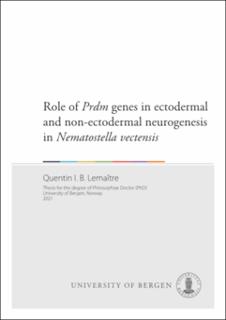| dc.description.abstract | The origin and evolution of the nervous system is a long-standing question in biology to understand the complexity observed today. Developmentally, the nervous system arises from the outer germ layer: the ectoderm. Nevertheless, several examples of mesodermal and endodermal contributions to neurogenesis have been described in bilaterians. In cnidarians, the nervous system is, completely or partly, derived from the internal germ layer, the mesendoderm. As the sister group to bilaterians, cnidarians hold an informative position to understand the cellular and molecular mechanisms underlying early aspects of neurogenesis, as well as common features shared with bilaterians.
In the present thesis, I have investigated mesendodermal neurogenesis in the anthozoan cnidarian Nematostella vectensis, the starlet sea anemone. Previous work has identified NvPrdm14d as a candidate gene potentially involved in mesendodermal neurogenesis. Prdm genes encode transcription factors playing a role in diverse developmental processes, notably in neurogenesis. Expression analyses together with cell proliferation assays revealed that NvPrdm14d defines a subpopulation of proliferating mesendodermal neural progenitor cells. Moreover, the generation and analysis of a reporter transgenic line for NvPrdm14d, crossed with different existing reporter lines, showed that these progenitors generate mesendodermal neurons in the body wall and the mesenteries, including potential motoneurons. Lastly, the analysis of the reporter line transcriptome provided a panel of genes potentially involved in mesendodermal neurogenesis. These findings uncovered that mesendodermal neurogenesis occurs from a molecularly heterogenous population of neural progenitors in Nematostella.
Since the role of Prdm genes have not been investigated in Nematostella, I have screened the temporal and spatial expression of all NvPrdm genes. This analysis indicated that NvPrdm6d and NvPrdm13b are potentially involved in neurogenesis, notably in cnidogenesis, the development of cnidocytes, a cnidarian-specific neural cell type.
Altogether, this thesis offers new perspectives on the evolution of non-ectodermal neurogenesis, and on the evolution of the role of Prdm genes, notably in neurogenesis. | en_US |
